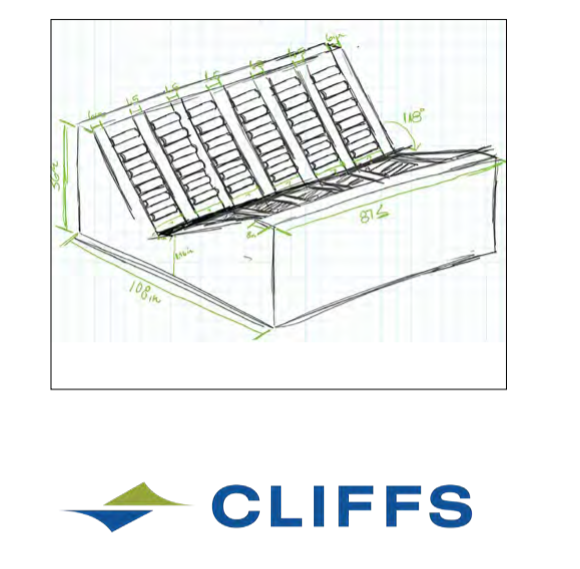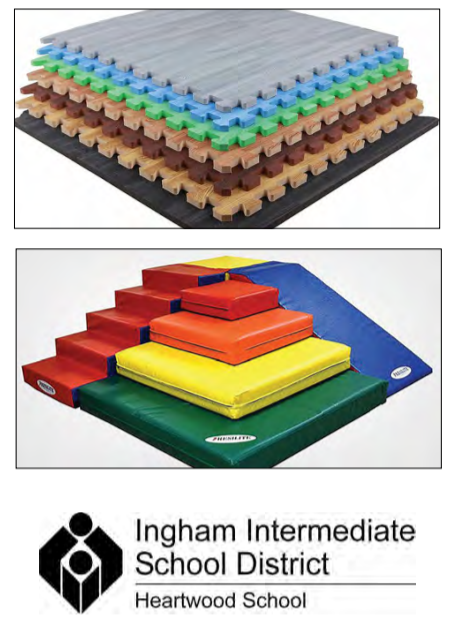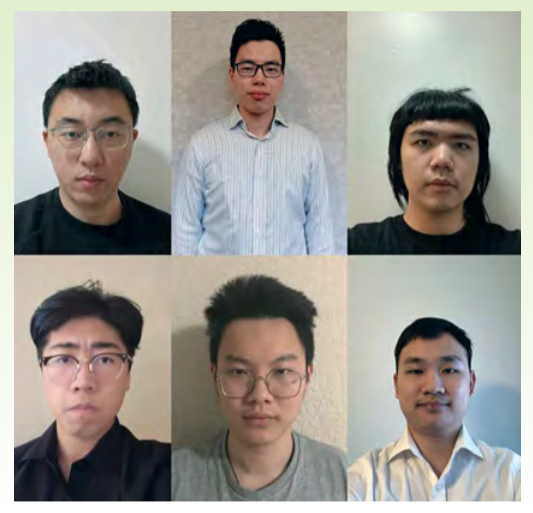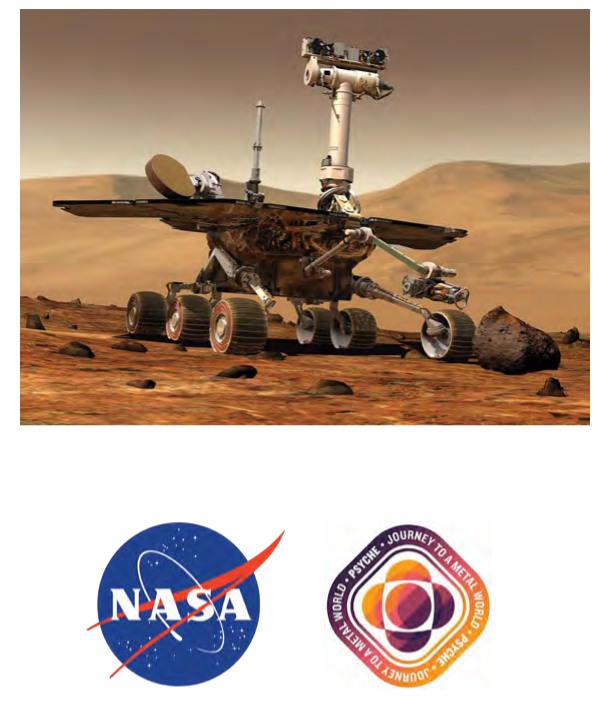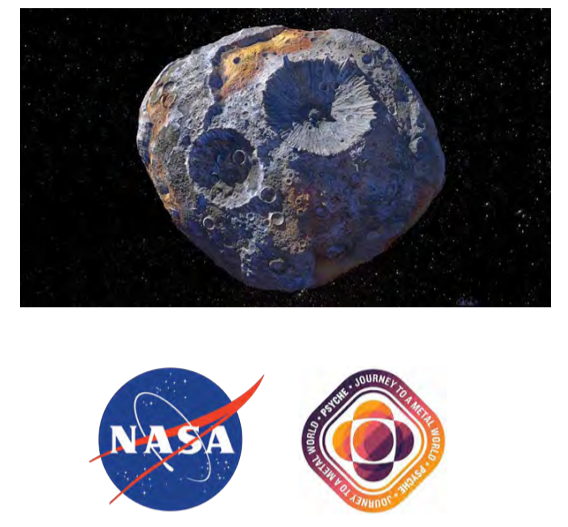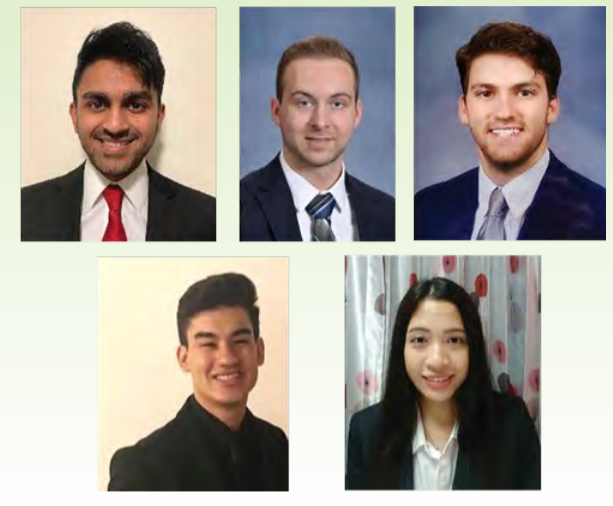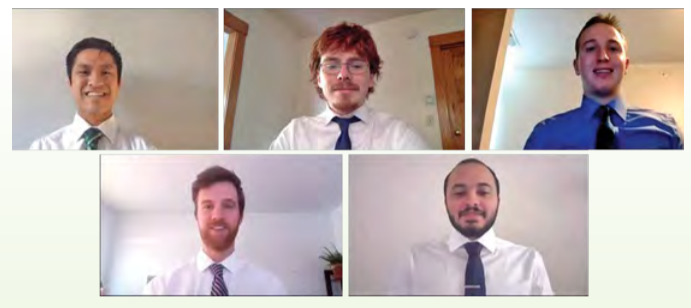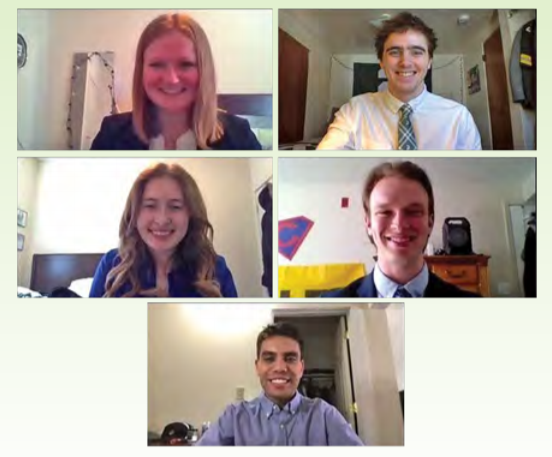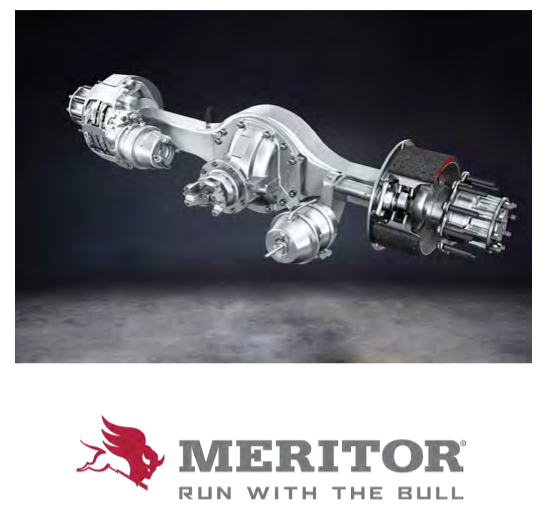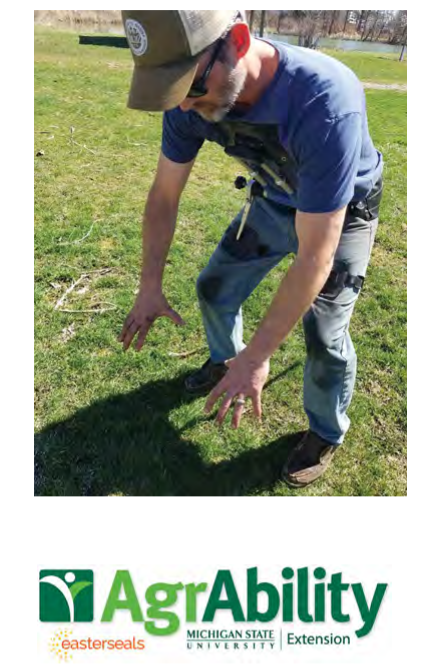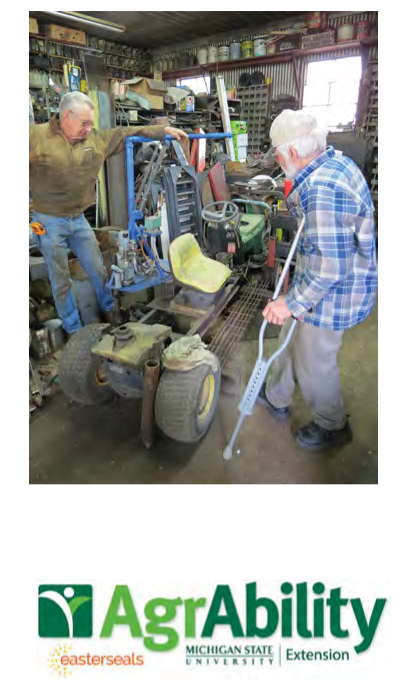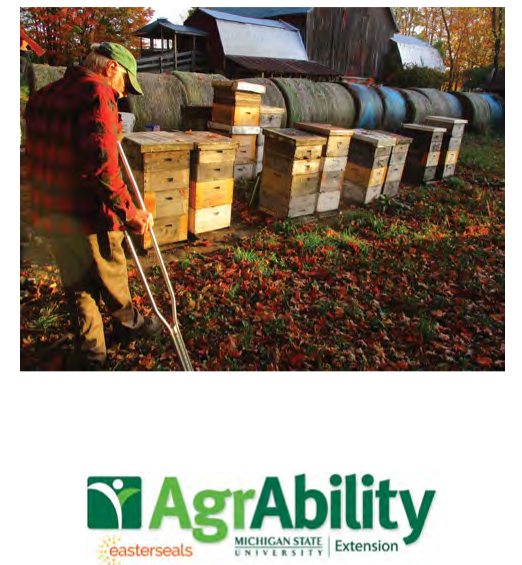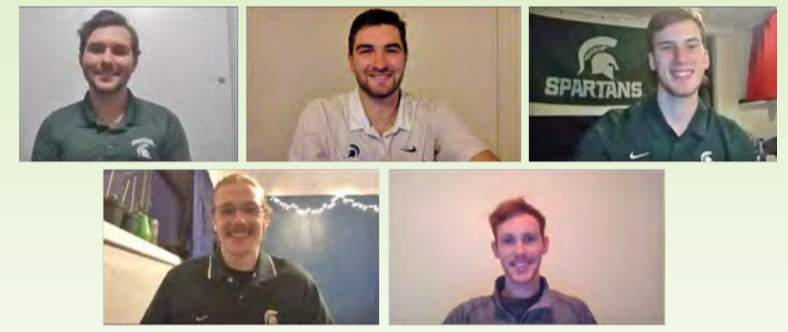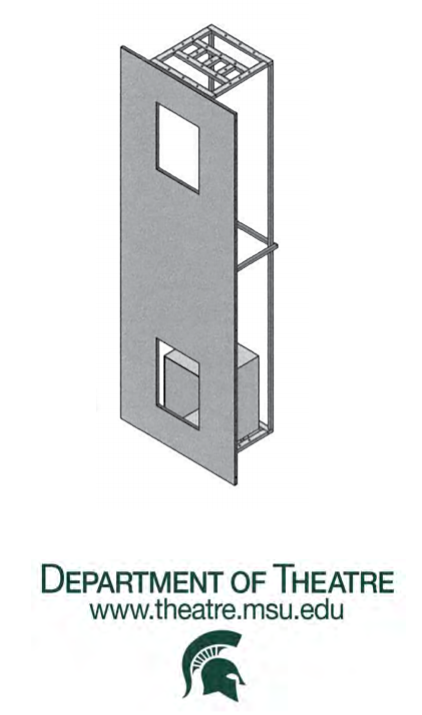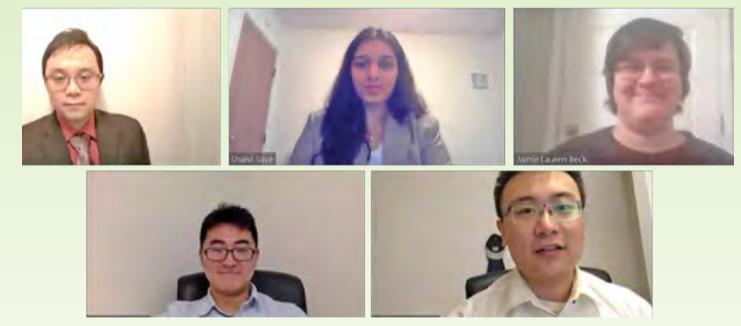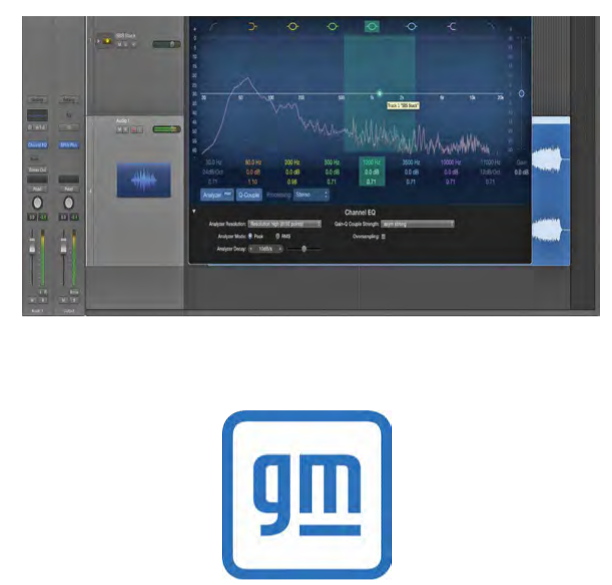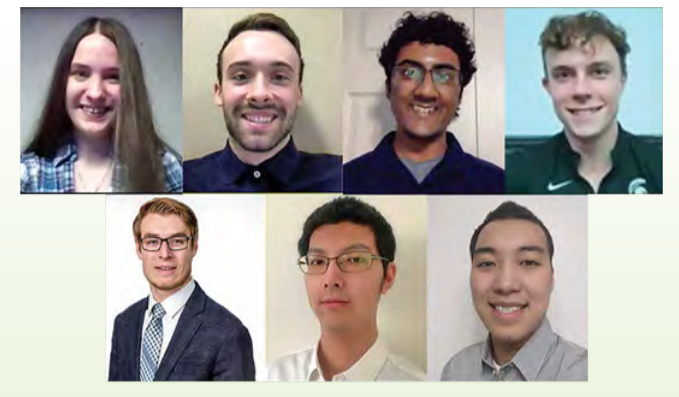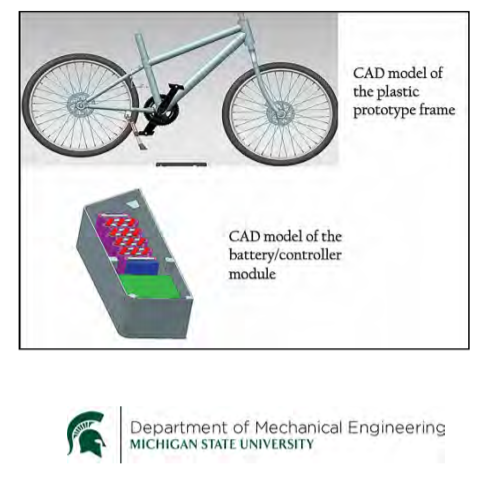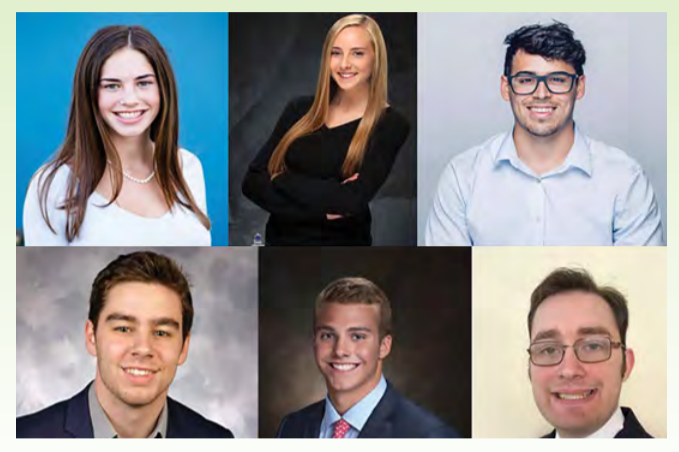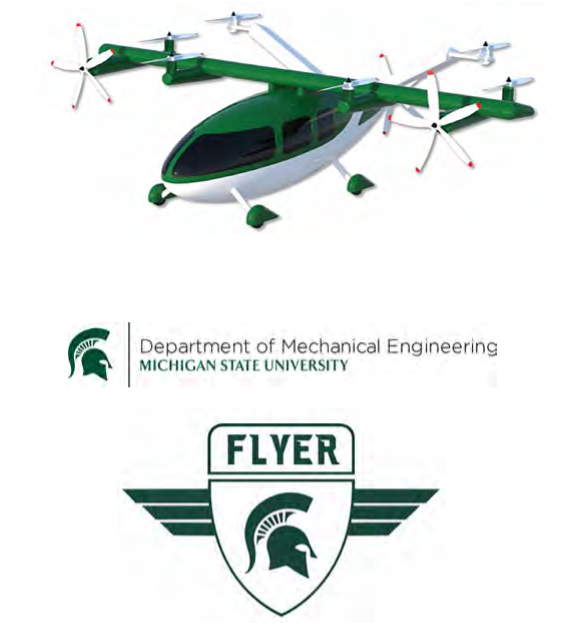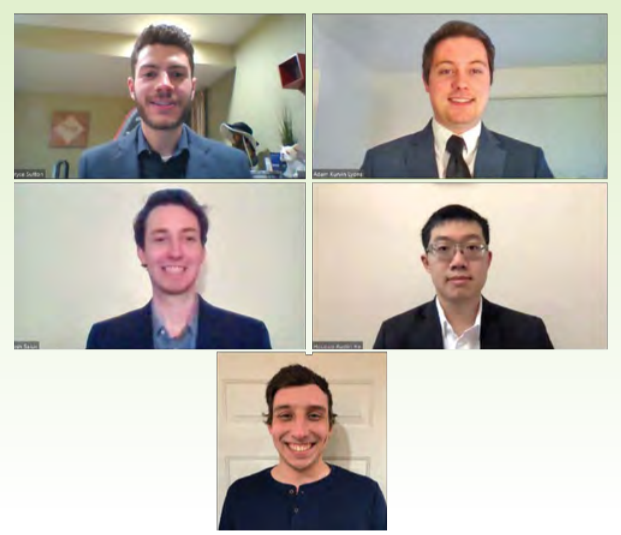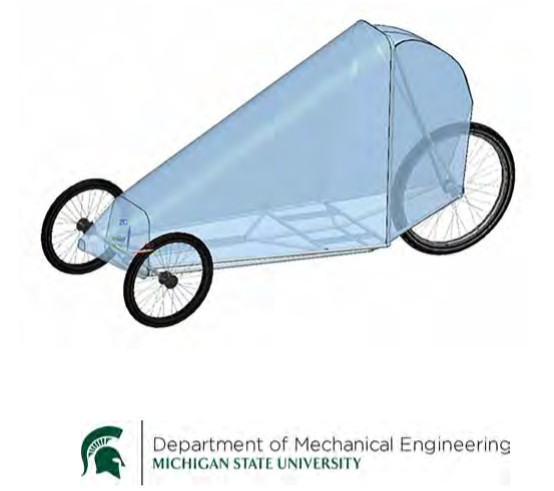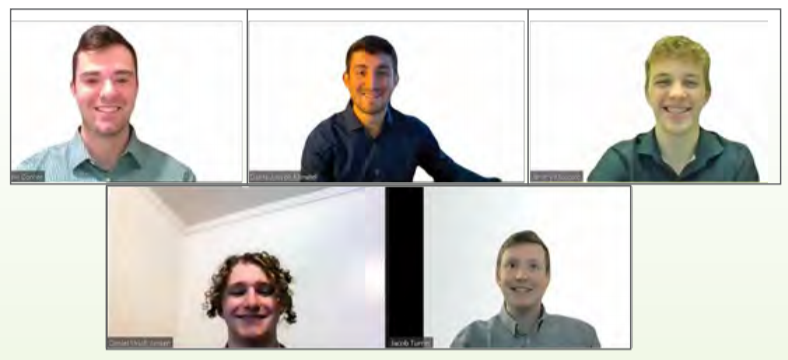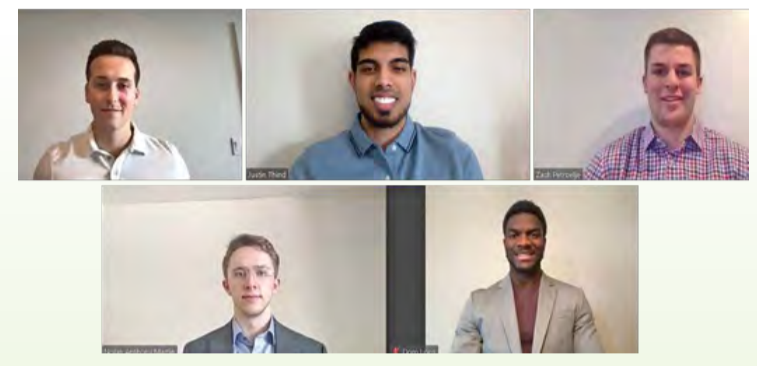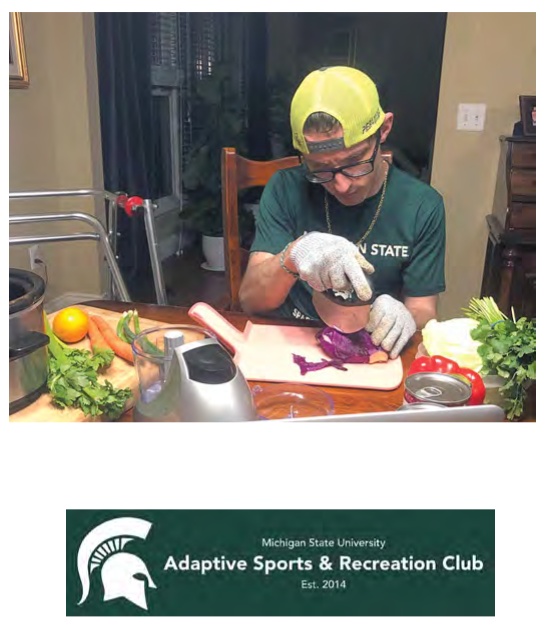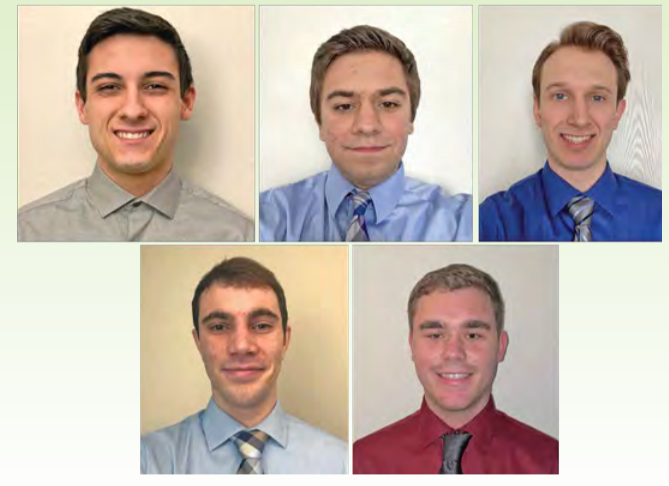Cleveland-Cliffs, Inc: Steel Coil Banding Station
Cleveland-Cliffs, Inc.: Steel Coil Banding Station 2
Cleveland-Cliffs, Inc.: Wrapped Weld Reprocess Station
Consumers Energy: Uninterrupted Service Replacements
Heartwood School/Ingham ISD: Adjustable Obstacle Course
Heartwood School/Ingham ISD: Outdoor Movement Story Path
Heartwood School/Ingham ISD: Indoor Movement Path
NASA/Arizona State University: Sampling System for Hypothesized Surfaces
NASA/Arizona State University: Sampling System for Hypothesized Surfaces 2
NASA/Arizona State University: Robotic Explorer for Hypothesized Surfaces
NASA/Arizona State University: Robotic Explorer for Hypothesized Surfaces 2
Steelcase: Conference Room Table – Passive Damping System
Holt Public Schools/Ingham ISD: Lift for Zeke
Meritor, Inc.: Carrier Pinion Retention Feature
Michigan AgrAbility/Heroes to Hives: Back-support Brace for Women
Michigan AgrAbility/Heroes to Hives: Powered Trolley and Boom for Beehive Crane
Michigan AgrAbility/Heroes to Hives: Tongs for Lifting Beehives
MSU Department of Theatre: Dumbwaiter Design
MSU Department of Theatre: Dumbwaiter Device
Flash Steelworks, Inc.: Shelter Door
Flash Steelworks, Inc.: Flash Safety Door Design
General Motors: Octave Band Equalizer Tool MSU Department of Mechanical Engineering: ISD E-Bike Fabrication and Development
Energy and Automotive Research Laboratory: Hybrid Power System for VTOL Aviation Vehicles
Energy and Automotive Research Laboratory: Aerodynamic Analysis of VTOL Aviation
MSU Department of Mechanical Engineering: HPVC Aerodynamic Fairing Design
MSU Adaptive Sports and Recreation Club: Inclusive Wheelchair Design Phase IV
MSU Adaptive Sports and Recreation Club: Sled Hockey Transfer Platform
WestRock: Evaluate the Location of the Upper Deck and Carousel
Sistema.bio: Bio-Digester Solids Movement Processing Design
MSU Adaptive Sports and Recreation Club: Accessible Cutting Board
Cleveland-Cliffs, Inc: Steel Coil Banding Station
Cleveland-Cliffs is the largest flat-rolled steel company and the largest iron ore pellet producer in North America. The company is vertically integrated from mining through iron making, steelmaking, rolling, finishing, and downstream with hot and cold stamping of steel parts and components. One of the main products that ClevelandCliffs manufactures and sells is steel coils. They are made from mined iron pellets that are melted down into slabs, rolled to a thickness of .05 inches with an average length around 10,000 feet long, and then rolled into a coil for further processing. These steel coils are extremely heavy, ranging from 10,000 pounds to 80,000 pounds but average 50,000 pounds, with the width of the coils ranging from 32 inches to 75 inches. The coils are held together by bands, which are uniquely oriented for the customer receiving the coil.
Movement of the coils requires using a crane, and the coils are moved frequently around the plant to be put into storage or moved to another location for further processing. Due to the frequent movement, the bands will occasionally break, causing the coils to unravel. These coils then need to be placed down and re-banded.
Our team has designed a station for Cleveland-Cliffs so that if a band breaks, there is a safe way for the coils to be rebanded. The designed station creates a safe way to allow for the coils to be recoiled with the help of some polyurethane covered rollers. These enormous steel coils can now be re-banded efficiently without the risk of a life-threatening injury to the operators on the floor.
Cleveland-Cliffs, Inc.: Steel Coil Banding Station 2
Cleveland-Cliffs, Inc, headquartered in Luxembourg, Luxembourg, is the world’s leading steel and mining company. With more than 190,000 employees and steel manufacturing plants in 18 countries, it is the leading supplier of quality steel products in the North American, Asian, and European markets. These include automotive, machinery, pipe and tube, construction, container, and appliance. Its foremost goal is to build a better world by inventing smarter steels. Cleveland-Cliffs manufactures steel in the form of large coils that are moved by a crane to different locations up to ten times and are then placed in storage areas with other coils. Due to the vast amount of movement, the band holding the coil together will occasionally break.
Currently, there is no safe way to re-band these coils before they are transported to the next station. There are safety concerns with operators standing near the coil when it is being moved by the crane. Our team’s project is to design a station where these un-banded coils can be safely re-banded without putting workers in unnecessary danger. Since Cleveland-Cliffs’ coils come in different sizes, the re-banding station supports any size coil. Another important feature is that the re-banding station can re-band the coil in as many orientations as possible since customers prefer different types. We focused on a solution that is cost-effective, can be manufactured out of steel, and issafe and reliable. With this newly implemented steel coil re-banding station, Cleveland-Cliffs can easily transport its re-banded steel coils to the next location.
Cleveland-Cliffs, Inc.: Wrapped Weld Reprocess Station
Cleveland-Cliffs, Inc. is an integrated steel mill located in East Chicago which mines iron ore pellets out of the ground and melts them down into slabs of steel. These slabs are then rolled out into steel coils 0.5 inches thick. These coils of steel can weigh anywhere between 10,000 and 80,000 lbs, and measure anywhere between 32 and 75 inches wide. To have the coils efficiently run on a process line, they are welded together with the tail end of one coil welded to the head of the next coil. Currently, there is a station at the end of the process line where an operator cuts the weld, resulting in the separation of the two coils. However, the operator sometimes will miss the cut, and the weld will be rolled into the outer loops of the coil. Once this happens, the coil then needs to be transported, using cranes and tractors, to the reprocess line where it will be fixed, and then returned to where it came from on the process line. This whole process can take up to two weeks, resulting in a major setback in delivering the product to the customer.
Our team has been tasked with creating a station at the end of the process line that would be able to unroll the coils where missed cuts occurred to a position where the weld could then be successfully cut by an operator using a hand torch. To do this, the coil will need to be able to roll out about three laps. After the weld is cut, the station would then need to be able to roll the coil back up. Another requirement for the station is the ability to hold any size coil with a minimum factor of safety of 1.5. The station will be made out of structural steel and designed using CAD and FEA software to ensure the requirements are met and are feasible. The resulting impact of the project would be to save Cleveland-Cliffs money, time, and improve customer satisfaction.
Consumers Energy: Uninterrupted Service Replacements
The primary objective of this project is to create a method
of maintaining gas service a customer’s home while the
existing service line to the meter is being replaced. The
team will essentially be designing a jumper device to transfer service from an old gas line to a new gas line without stopping service to the house.
Currently, before a field worker begins to replace the existing service line, Consumers Energy shuts off gas to the meter. Thus, all gas appliances downstream of that meter will no longer be supplied with gas. In order to restart these appliances once the new line is installed, the field worker must go into the building to relight each gas appliance, which can be challenging if the building owner is not available, to let the field worker inside. There are no current methods in place that allow continuous service to the meter while the service line is being replaced.
Constraints for this project include the need to regulate the pressure of the gas, have proper seals to prevent a gas leak and prevent oxygen from entering the fuel lines, and be safe to use with live natural gas. In addition, the team must ensure the design fits between the house and the meter and design a solution that is ergonomic for the field worker to operate. The design should also take into consideration the company’s goal to reduce cost by eliminating the need for a return trip to relight appliances.
The expected deliverables for the project include a completed 3D model of the team’s design in CAD and a detailed economic comparison between the team’s design and the original cost of returning to the building to relight appliances.
Heartwood School/Ingham ISD: Adjustable Obstacle Course
Heartwood School is a school that works within Ingham
Intermediate School District focusing on serving students with moderate to severe cognitive disabilities, autism spectrum disorders, and physical disabilities. Many of these students have difficulty navigating and accessing everyday obstacles such as stairs and different surface types. To help these students, Heartwood School often sets up obstacle courses through which the students can try to maneuver. However, these obstacle courses can be difficult to set up and take time to rearrange for students with different levels of mobility.
Our project is to design, test, and build an obstacle course that is simple to assemble, customizable to meet different students’ needs, and able to simulate different types of surfaces. This obstacle course would be built with the aim of allowing teachers at Heartwood to easily set up the course in a way that simulates a real-world environment within the safety of Heartwood’s walls. In addition to this, we would like to make the obstacle course in a way that allows students to make their own courses in the comfort of their own home. This feature is extremely important, as some students are unable to attend Heartwood Schools in person due to the risk of health complications from the current pandemic. With this in mind the course would need to be built sturdily enough that students could not take apart small pieces of the course and potentially swallow them, leading to choking hazards.
The design of this obstacle course would allow students with all types of disabilities to better navigate the world around them so they can live more comfortable and safer lives.
Heartwood School/Ingham ISD: Outdoor Movement Story Path
Heartwood School is a center-based program located in
Mason, Michigan and is part of the Ingham Intermediate
School District. Heartwood serves students from 2.5 to
26 years old with moderate to severe cognitive impairments, severe multiple impairments, autism spectrum disorders, and physical impairments. Heartwood School has its own specialized curriculum, which incorporates a program called MOVE. This program adapts to individuals’ present abilities with an instructional process to incorporate motivational activities for improvement of mobility skills such as sitting, standing, walking and transitioning. The Outdoor Movement Story Path is a fun and interactive approach to the MOVE program to integrate mobility and sensory activities throughout a student’s day. Multiple outdoor stations need to be able to withstand weather elements corresponding to interactive stories for development of literacy, mobility, social, and sensory skills. Each station has a place for two letter sized portions to be added that allow for different book or exercise pages along with a smaller window for a communication CORE word. Additionally, each station will correspond to themes such as sound, touch, exercise, and cognitive stimulation.
Our project is to provide blueprints for the Outdoor Movement Story Path concept for improvement of the MOVE program. The main risk for this project is injury to the students. Hence, the design does not include any protruding material, and the detachable top board contains a safety locking mechanism. To adapt to outdoor weather conditions, all components are weatherproofed. The stands are also able to withstand the force of students pushing down or leaning on them. Sanitizing of stations is essential in maintaining the health and safety of the students and faculty.
Heartwood School/Ingham ISD: Indoor Movement Path
Heartwood School serves students in the Ingham ISD service area who are eligible to receive services under the categories of moderate and severe cognitive impairments, severe multiple impairments, and autism spectrum disorders. Heartwood staff work with local school districts and families to provide center-based programs and services to students, as determined through the IEP process. Heartwood School does not enroll students independent of local involvement. Children who attend Heartwood School are between the ages of 3 and 26.
Heartwood students need more opportunities to
incorporate mobility and sensory activities throughout their day to have more practice and development of their skills. This project involves developing a plan for a motor/sensory engagement inside with various stations to incorporate more motor/sensory opportunities within the school environment together with literacy and CORE opportunities as appropriate and possible.
NASA/Arizona State University: Sampling System for Hypothesized Surfaces
Aspace mission called Psyche is set to launch in 2022. This mission is targeted to learn more about the building blocks of planet formation. Psyche is an asteroid in the asteroid belt between Mars and Jupiter that is likely made largely of metal from the core of an early planet. The goal of the mission is to determine if this hypothesis is true and figure out the makeup of the surface of this asteroid. Psyche is the only known place in our solar system where we can examine directly what may contain metal from the core of an early planet. If this mission is a success, it is possible engineers and scientists might want to propose a follow-on mission to land on the asteroid for an actual sample of the surface.
Such a mission would involve collecting samples from the asteroid and transferring them back to Earth for further analysis. For this analysis to be successful, an efficient and reliable sampling system must be engineered to ensure the quality of asteroid samples.
One of the challenges of this project is the lack of knowledge of what Psyche’s surface consists of because it is believed to be some mixture of metal and rock. This system must include a proper extraction device along with an organized caching system to store the samples as the spacecraft travels back to the Earth in the future.
The deliverables that are needed for this mission to be successful include a fully operable 3-dimensional computer-aided design program, along with proper testing while considering all potential constraints listed in above sections.
NASA/Arizona State University: Sampling System for Hypothesized Surfaces
The NASA Psyche Mission is set to launch in 2022 and arrive at the asteroid in 2026. It is an orbiter mission and will not land on the surface. It is possible to imagine, however, that after learning about Psyche from orbit, there may be scientists and engineers interested in proposing a subsequent mission to actually land on the asteroid and sample its surface. In this capstone project, we are that team!
Designing to the range of hypothesized surfaces that might be found at Psyche (and keeping in mind other constraints such as its gravity), the team has been asked to design a sampling system capable of effectively extracting scientific samples from each of the hypothesized surfaces and, potentially, a single caching system able to cache each type. Hypothesized surfaces may include mostly flat metallic surface, flat metallic with metal and/or rocky debris, rough/high-relief metallic and/or rocky terrain high relief metallic crater walls.
Over the course of the project, the team will create preliminary and final designs of the Psyche sampling system. These deliverables include computer aided designs of the sampling and caching systems along with finite element analysis on all load-bearing components. Additionally, a theoretical control system is to be designed to model autonomous control of the sampling system to account for communication latency from Earth.
NASA/Arizona State University: Robotic Explorer for Hypothesized Surfaces
The National Aeronautics and Space Administration (NASA) is an independent agency of the U.S. federal government responsible for the civilian space program, as well as aeronautics and space research. NASA’s mission is to “drive advances in science, technology, aeronautics, and space exploration to enhance knowledge, education, innovation, economic vitality and stewardship of Earth. Core Values: We share a set of core values—safety, integrity, teamwork, excellence, inclusion—and they are evident in all that we do.” Currently, NASA is attempting to explore smaller bodies in space.
The Psyche mission is a journey to a unique metal asteroid orbiting the Sun between Mars and Jupiter. The mission is led by Psyche Principal Investigator Lindy Elkins-Tanton of Arizona State University. NASA’s Jet Propulsion Laboratory is responsible for the mission’s overall management, system engineering, integration and test, and mission operations. Maxar Technologies is providing a highpower solar electric propulsion spacecraft chassis.
Our team was responsible for designing a rover that could potentially be used to traverse the asteroid Psyche during a future surface mission. Psyche presents many unique challenges including low gravity, low solar radiation, and lack of an atmosphere. Utilizing a unique propulsion system accompanied by an innovative ground movement system, our design allowed the rover to traverse across many different hypothesized surfaces, ranging from a flat, metallic surface to rocky terrain with high-relief crater walls.
NASA/Arizona State University: Robotic Explorer for Hypothesized Surfaces
NASA is the U.S. government agency responsible for science and technology related to air and space. In collaboration with Arizona State University, located in Tempe, Arizona, NASA’s Psyche Mission team has asked mechanical engineering capstone teams to design a rover capable of traversing the complex terrain of the Psyche asteroid’s surface. The NASA Psyche Mission is set to launch in 2022 and arrive at the asteroid in 2026. It is an orbiter mission and will not land on the surface. After learning about Psyche, scientists and engineers may be interested in proposing a subsequent mission to land on the asteroid and explore its surface.
Our team designed a robotic explorer capable of traversing the range of hypothesized surfaces and ideally adapt to each of them mid-traverse. The project is collaborative to engineer the method of movement and chassis design to effectively collect and analyze data. The surface of Psyche is largely metallic and rocky with large hill gradients to take into account. The overall shape, design, weight, power, and other parameters were designed to account for the overall mission and ensure flawless performance. An understanding of the environmental conditions such as the temperature, sunlight, gravity, and lack of atmosphere are clear parameters that will constrain our design.
Steelcase: Conference Room Table – Passive Damping System
S teelcase, located in Grand Rapids, Michigan with additional locations and dealers around the world, is a developer of architecture, furniture, and technology products. First producing metal wastebaskets in 1912 to reduce the number of office fires, their goal is to continue to innovate the workplace.
Steelcase’s catalogue ranges from classroom desks to conference room and casual living room tables. It is commonly considered that the quality of a table/desk can be related to its stability. While there are many structurally sound tables on the market, they are often supported by materials that increase the weight of the table and reduce the space of the user. Creating a product that reduces the need for such supports may lower the cost and ease the process of manufacturing. Developing cheap, yet reliable tables would be beneficial to schools, small businesses, and other organizations with limited funding.
Our team has been tasked with designing, manufacturing, and testing a passive damping system for desks and tables to reduce the oscillation and settling time due to horizontal impacts. Since Steelcase produces a variety of products, the device must be tunable and modular in order to adapt to different leg sizes and table masses. In order to maintain the table’s visual appeal and the user’s space, the product must also be concealable and aesthetically pleasing. The device should enable the table to meet industry standards, which include reducing initial displacement by 90% after six seconds. Benefits of this device include increased user comfort, enhanced perception of the table’s quality, and increased lifespan. There are very little downsides or risks associated with the addition of this device, aside from waste caused by premature disposal of old tables. The success of this project may allow Steelcase’s products to be designed differently with implementation of our accessory in mind.
Holt Public Schools/Ingham ISD: Lift for Zeke
Ingham ISD creates a space for all students/learners in the community offering support, resources, and enhanced education.
Zeke is an intelligent and outgoing sophomore student at Holt High School who has a condition called Quadramelia/Amelia, meaning he was born with no arms or legs. He is dependent on one or even two aids/ caregivers who assist him in his day-to-day activities including using the bathroom. Zeke enjoys the sense of independence when being in his wheelchair and in full control, but when it comes to transitioning from different chairs, Zeke loses much independence. Transitioning from one chair to another is also a big challenge for Zeke and his caregivers. Zeke now weighs over 70 pounds and needs a lift that provides him more independence during his transitions and can safely lift him without the strain on caregivers. This project is designed to meet those goals.
Project designs completed by multiple former MSU engineering teams addressed the need of helping Zeke move from his wheelchair onto another chair and maneuver him onto the ground. This evolving device was redesigned in Spring 2020 and Fall 2020 but never had the opportunity to be prototyped and tested on Zeke. Current design work revolves around the most recent redesign with a few tweaks to ensure Zeke has full mobility on his own as he transitions from his wheelchair to another chair. To help with storage and maneuverability within Zeke’s house, making this lift as compact as possible is one of the main goals for the build, along with providing more options for movement such as 360-degree rotation. A stable attachment system from Zeke’s wheelchair to the lift is necessary to ensure Zeke’s safety during transition.
This project is expected to reach the build phase to provide Zeke a prototype with added mobility and independence.
Meritor, Inc.: Carrier Pinion Retention Feature
Meritor, Inc. is a global corporation that designs and
manufactures commercial truck components. More specifically, Meritor product offerings include axles, brakes, drivelines, and suspensions.
For the purpose of our design project, we are focusing solely on the assembly and disassembly process relating to drive axles. A drive axle is the core shaft involved in making a vehicle’s wheels turn, and support vehicle weight. At the heart of typical axle designs is a bevel gear set, which consists of a ring gear and a pinion gear. This gear set is constantly under varying amounts of load, meaning that the design of the axle systems is critical in ensuring proper performance and durability. One component found in axle designs is a pinion nut, which maintains preload to the pinion bearing system, while preventing any movement of the pinion within the axle. Therefore, retaining the pinion nut is an essential part of a successful axle design.
Although Meritor’s current design of such nuts provides sufficient performance while in service, complications can arise during disassembly, either during service procedures or adjustments commonly used during manufacturing of the axles. Our challenge this semester is to design a new and improved pinon nut retention feature that meets the load and durability requirements, while also
allowing easy removal without damage to the axle system and with minimal cost increase.
Michigan AgrAbility/Heroes to Hives: Back-support Brace for Women
Michigan AgrAbility, headquartered in Grand Rapids, Michigan, is a
program that partners Michigan State University Extension with
Easterseals, a non-profit disability assistance organization, in an effort to support the advancement of agricultural workers that have disabling injuries and illnesses. Michigan AgrAbility devises individualized solutions for their clients across the state, restoring them with the productivity and freedom that their disabilities took away.
Recently, the need of a back brace arose to support women beekeepers that spend extended periods of time bending over to inspect hives. Ned Stoller, an Assistive Technology Professional with Michigan AgrAbility, has had previous success assisting clients who have debilitating back pain with a device called the Springzback. The Springzback, developed by Mike Babcock, is a spring loaded device capable of supporting its user in a variety of bent over positions by distributing the stress away from the back muscles. The problem is that its frontal chest plate can be uncomfortable for women to use.
With the sponsorship of Heroes to Hives, a Veterans Beekeeping Program with MSU Extension and Michigan AgrAbility, our team has been tasked with designing and building an upper-body support piece for the Springzback that will be comfortable for women beekeepers to use. In order to design a comfortable and effective product, the team must consider the beekeeper’s range of motion needs and device size, as well as load distribution and the material limits of the device’s components. A successful solution will be able to transcend beekeeping and provide women around the world with comfortable back support and improve their quality of life.
Michigan AgrAbility/Heroes to Hives: Powered Trolley and Boom for Beehive Crane
Michigan AgrAbility was founded in 1992 in order to aid Michigan farmers that are affected by injury, disease, or disability. Aid for farmers in need is provided in the forms of modified farming tools, special equipment, or new methods to allow the farmers to partake in all operations necessary to upkeep their business. A current focus of Michigan AgrAbility is finding a solution for disabled farmers to be able to properly care for their bees, due to the increase of diseases within beehives and the decreasing honeybee populations in the region.
In order to successfully raise bees, beekeepers are required to regularly inspect their hives. This has been a challenge for Bob Bernard of Earthwork Farm in Moorestown, Michigan who was paralyzed from an illness over 40 years ago. Bob is able to get around using crutches, but trying to lift and inspect a 90-pound beehive is not something of which he is capable. To solve this issue, Bob began modifying a John Deere lawn tractor to suit his needs. The tractor needs to feature an overhead crane capable of lifting hives off of the ground and moving them to a position next to Bob’s seat on the tractor for personal inspection.
Our team was given the challenge of assisting Bob with this crane by designing a powered trolley to travel the length of the crane boom after a hive has been lifted. Controls to operate the trolley also need to be implemented in a position where Bob can access them while operating the tractor. Upon successful testing of the boom and trolley, the team will prepare construction drawings and instructions to provide to other beekeepers, with the expectation that other smallscale honey producers will utilize our technology.
Michigan AgrAbility/Heroes to Hives: Tongs for Lifting Beehives
Michigan AgrAbility provides critical assistance to enable people in the agricultural industry with an injury,
illness or disability to continue working. Beekeepers
with back, leg, and arm injuries cannot lift hive bodies to inspect for queen health, mites, and viruses. With the increase of diseases in beehives and reduction in honeybee populations, it is more important than ever for beekeepers to perform frequent inspections of their hives. Cranes mounted on trucks and trailers are used by commercial beekeepers to lift pallets of hives. There is no device available in the USA for the hive-lifting cranes to grip and lift the individual hive bodies.
Our team has designed and manufactured a crane attachment capable of lifting single or multiple hive bodies with minimal manual labor. The tongs are suspended from a crane and lowered into position for the desired number of hive bodies. The unique, inverse scissor design uses mechanical advantage to convert the tension from the weight of the hives into horizontal pressure that grasps the finger-pockets on the sides. The length of the tongs and tension angle are adjustable to accommodate various hive configurations and weights.
We focused on making an easily manufacturable, yet rigid design that can be replicated by beekeepers around the country. This product will eliminate the need to manually lift hives that can weigh up to 90 lbs, enabling any beekeeper to manage their hives in an accessible and safe manner.
MSU Department of Theatre: Dumbwaiter Design
The MSU Department of Theater is participating in the Stage Machine Design challenge, where teams of students compete to design a dumbwaiter lift mechanism. The dumbwaiter itself is used during theater productions to move props from the first floor to the second floor and vice versa. Organizers of the competition provide teams with the shaft in which the dumbwaiter cab will travel and sizes of the openings on each floor with which the cab must align.
Our team has been asked to create a mechanism that will raise
and lower the dumbwaiter cab including any components that help
stabilize the cab as it travels in the shaft. We will also design a cab that fits into the specific dimensions of the given shaft. The mechanism must be capable of lifting various weights of up to 120 pounds and travel from floor to floor at different speeds. It will also be a persondriven mechanism that the average student would be able to easily operate.
MSU Department of Theatre: Dumbwaiter Device
The Michigan State University Department of Theatre is located on the Michigan State University campus in East Lansing, Michigan. The department has been challenging the traditional and fostering innovation in order to create something that is new, unique, and fresh. This is being done by utilizing the most advanced stage technology to allow designers the opportunity to defy conventional design. One such technology that the department is currently looking to implement during their productions, is that of a dumbwaiter. A dumbwaiter is like a small elevator, typically used to carry smaller items between the floors of a building or a tall structure with different speeds. The implementation of a stage machine dumbwaiter will increase efficiency, minimize physical strain, and save time.
Our team has been tasked with designing a dumbwaiter device
for raising and lowering a given dumbwaiter shaft. This would allow for easy transfer of props between two floors within a short amount of time. The device is manually operated (person-driven) and can transfer objects with weights and velocities ranging from a 14-pound bowling ball in a bag within 15 seconds (traveling both up and down), to a 120-pound bag of dog food within 2 seconds. This device must be compatible with the given dumbwaiter shaft and wall dimensions. It also must include any elements that will prevent lateral movements of the dumbwaiter cab when operating the mechanism. The dumbwaiter mechanism is designed to be operated by a typical college student; so in other words, the person has a maximum force of 40 pounds, and a sustained force of 25 pounds.
Flash Steelworks, Inc.: Shelter Door
Flash Steelworks, Inc is an R&D firm specializing in the development of armor plate and advanced high strength steel. While this is a crowded field in which 10,000 metallurgists work annually, the US Dept of Energy’s website has called Flash “the world’s leading performing material for lighter and stronger vehicles.” Work with US DOE is based on prior research with the US Army that has been scaled down in thickness from 6.3mm thick plates to sheet metal from 0.5mm to 2.0mm thick for use in civilian applications.
It is the proposed scope of this project to design an armored shelter door using Flash Armor, Tubing, and Sheet. A rudimentary design has been concepted while our team is tasked with analyzing and refining the initial door’s performance.
A doorframe is proposed based on welded I-beam construction to encapsulate the door and locking attachments. We will analyze best methods for connecting the door to existing construction and make recommendations for installation in new construction, including in panic rooms, tornado shelters, and bunkers. Hinges, bolts, vapor seals, and other non-Flash components can be recommended from commercially available sources. Information will be provided to analyze theoretical blast forces and the impact on the door, frame, and surrounding structure using CAE. This will include modelling of both the environment and components of the overall construction. Ballistic data, as provided by US Army Research Lab, will be provided if appropriate. This project will utilize rigorous FEA modeling to insure a robust design for maximum protection. While important, aesthetics, door closing rate, and pinch points are secondary.
Flash Steelworks, Inc.: Flash Safety Door Design
Flash Steelworks, Inc is one of the leading companies in the armor steel plate industry. With their field, leading heat-treatment technology, they have developed a lowcost process to create lightweight and stronger steels. The process of heat treatment is unique to Flash Steelworks. The steel is heated to over 1000 degrees Celsius in seconds, and once it reaches that temperature the steel is quickly quenched. This technology is currently being used in military and civilian projects all over the country. With their patented Flash Processing, Flash Steelworks has the ability to create lower cost safety equipment and mechanisms for the public.
Flash Steelworks has asked our team to incorporate their sheet steel and Flash Armor to create an affordable bulletproof door that can easily replace a standard school or office door. Our task is to implement readily available products such as locks, peepholes hinges, door assists, and foam to absorb bullet fragments within the door. This product will be able to protect offices and classrooms from a range of bullets including armor piercing and AR-15.
Our team’s hybrid solution will involve bringing together multiple products to combine with Flash Steelworks’ leading Flash Armor, to create a powerful low-cost bulletproof door. This design will provide Flash Steelworks with a product that is capable of replacing standard doors with no or limited modifications to the existing frame.
When implemented, we expect that this door can be used to save the lives of hundreds of people in school and office shootings.
General Motors: Octave Band Equalizer Tool
GM, headquartered in Detroit, is a global leader in automotive manufacturing. With over 85 thousand employees and 122 facilities in the US, GM is at the forefront of the automotive industry. Safety is at the center of everything GM does. One consequence of electric vehicles is the need to provide audible sound from the vehicle to provide information to pedestrians about the vehicle’s location and movement. Minimum external sound is now required to satisfy US federal and other global regulations for all hybrid and electric vehicles.
Our team has been asked to create software that can produce a sound that is compliant with federal regulations. This software needs to receive a .WAV (waveform audio file format) file and break it into one-third octave bands. The software will be able to adjust the level of each of these octave bands. After this, the software will be able to output the final sound, which will be 3-5 seconds, as a .WAV file.
The final goal is for this plugin to be compatible with Logic Pro. This tool will improve the workflow speed and accuracy for GM sound engineers, as well as improve the safety of GM vehicles.
MSU Department of Mechanical Engineering: ISD E-Bike Fabrication and Development
Transportation in society today is constantly changing. New
methods for transportation are developed daily. Whether it
involves electric vehicles or ride-sharing programs, the future
of transportation is in the hands of today’s engineers and innovators.
In the past few semesters, ISD teams have spent countless
hours on designing the frame and manufacturing a prototype of the e-bike. Now, our team is responsible for identifying issues with the current prototype and finding solutions in order to fabricate the final prototype of the e-bike.
Some of the key challenges we face during the design process are performing the frame fabrication, implementing the battery/control module, and resolving some clearance issues with the frame and crankset. Once these issues are resolved and the manufacturing of the bike is complete, we will focus on some of the aesthetic qualities of the e-bike. The problem and solution are relevant to Michigan State Engineering because it requires the engineering design process and will lead to developing an electric commuter bike.
The most well-known bike companies such as Trek have e-bikes in the market. Although the team considered these products and processes, the bike is already a work in progress and, therefore, it was deemed more important to compare to previous work already performed on the bike. Nonetheless, comparing with corporate producers will allow the team to learn about different classes of e-bikes already in the market and the different functions they serve.
Completing the design and manufacturing process for this e-bike will not only benefit the team’s understanding of the engineering design process, but it will also display an understanding of what future transportation could look like on Michigan State’s campus.
Energy and Automotive Research Laboratory: Hybrid Power System for VTOL Aviation Vehicles
To diminish common traffic existing on our current
highway systems, project sponsor Dr. Harold Schock
proposes a possible solution via a Hybrid Vertical
Take-Off and Landing (VTOL) Aviation Vehicle. The intended purpose of the vehicle is to be capable of transporting up to six passengers, including a pilot. By utilizing this vehicle in modern transportation, a significant decrease in road congestion is possible. Similarly, the production of noise and air pollution produced by automobiles would also decrease.
As current transportation companies research fully
electric VTOL systems, several common issues emerge, primarily the minimal energy capacity current electrical systems can store. Current battery technology limits electric VTOL systems from achieving long range flights. The addition of an Internal Combustion Engine (ICE) allows for an increase in flight duration, speed, and overall capability. While this includes the addition of a fuel system resulting in the production of air and noise pollution, the amount of pollution generated by the vehicle is significantly less than byproducts generated by automobiles in traffic.
This is a continuation of a Fall 2020 Mechanical Engineering Design Project. The objective of the team is the completion and confirmation of previous assumptions to finalize the internal, external and powertrain designs. This will contribute to the accuracy of the simulated flight plans regarding flight duration, speed, and safety. The finalization of the project is a completely functional design, capable of cruise speed of 150 mph, and a flight duration of two hours with enough remaining power for 30 minutes of reserve time. All design criteria must also comply with current FAA flight requirements.
Energy and Automotive Research Laboratory: Aerodynamic Analysis of VTOL Aviation
I n recent years, traffic-based congestion within
major cities has cost commuters an average of 100 hours annually. In order to combat this issue, many companies have started investigating commercial vertical takeoff and landing vehicles (VTOL). These aircraft are specialized, capable of reaching flight altitude without the need of a runway. Many VTOL aircraft in development are being designed with electric propulsion systems. This would significantly reduce the noise and air pollution associated with automotive transportation. However, the technology required to commercialize fully electric VTOL systems is not yet feasible.
Dr. Harold Schock, Director of the Energy and Automotive Research Lab, supports the potential of VTOL but acknowledges that in order to commercialize these vehicles, a hybrid propulsion system must be used. By utilizing both electric and mechanical propulsion, VTOL aircrafts can reduce noise and air pollution, as well as support longer flight times and realistic cabin sizes.
With the help of Dr. Farhad Jaberi, the base VTOL aircraft design created in the previous semester will be analyzed utilizing multiple different software, including flow simulation, in order to optimize the aerodynamic performance of the wings, fuselage, and propellers. This will lead to a robust design that minimizes drag forces and maximizes the aircraft’s performance.
MSU Department of Mechanical Engineering: HPVC Aerodynamic Fairing Design
Michigan State University’s Human-Powered Vehicle Competition Team (HPVC) is a student-led racing team consisting of Mechanical Engineering undergraduate students. It was started in 2018, and the team competed in their first American Society of Mechanical Engineers (ASME) Engineering Festival in April of 2019. Since the first season, the team has focused on improvement and innovation in vehicle design.
The focus of this project is to design and test an
aerodynamic fairing for the vehicle that increases the speed of the vehicle by reducing the overall drag force. This fairing was requested by the HPVC team in order to improve their performance in the drag race portion of the ASME Engineering Festival. The team earns points in the competition in three categories: design, the drag race, and the endurance race. This project impacts two out of the three critical categories.
In order to meet the HPVC team’s objectives, we have designed and tested an aerodynamic fairing that fully encapsulates the rider in the vehicle and is also easily removable if the team needs to make adjustments to the vehicle or decides to take it off for the endurance event. By fully encapsulating the rider, the airflow over the fairing stays attached longer, and the rider is protected from any spilled air or turbulence coming off of the edges. Our design was tested both virtually and in a wind tunnel in the Engineering Building in order to determine both the integrity of the design as well as the impact this fairing will have on vehicle performance.
MSU Adaptive Sports and Recreation Club: Inclusive Wheelchair Design Phase IV
Wheelchair sports offer an enriching social and physical
outlet for people with disabilities, however they
unintentionally exclude certain ambulatory disabilities.
The MSU Adaptive Sports & Recreation Club aims to develop an inclusive sports wheelchair for people with disabilities that have muscle imbalances affecting their upper limb range of motion. These individuals cannot participate in able-bodied sports and face the challenges of using standard wheelchairs that are present in wheelchair sports.
The inclusive sports wheelchair provides individuals the
opportunity to engage in social sports from which they would otherwise be excluded. Proposed features such as a wheelchair propulsion method, increased steering control, and accommodations for either arm will allow players to participate in games with greater ease. This project will help the MSU Adaptive Sports & Recreation Club increase the satisfaction of its members.
Phase I of the project began in Fall 2017 and has since been through two prototype modifications, with Phase III being an entirely virtual design.
Our team was tasked with moving the Phase III design into the manufacturing stage by first evaluating the current design of the wheelchair (Phase II) and then implementing the main desirable components from the virtual design. Areas of concern include reliability, durability, and safety of the wheelchair user. Additionally, hands-free steering of the inclusive sports wheelchair and improving the working conditions were the end goal. Research and designs by previous teams aided in the production of an improved and inclusive wheelchair.
MSU Adaptive Sports and Recreation Club: Sled Hockey Transfer Platform
The MSU Adaptive Sports & Recreation Club, established in 2014, is a group at Michigan State University that aims to be
able to provide all people with the opportunity to partake in
sports and recreational activities. The program seeks to create and continually cultivate a physically and socially accessible space where athletes with physical disabilities and able-bodied volunteers come together to establish an integrated community of peers that will use sports and recreational activities to validate the disability experience by eradicating inaccurate societal stereotypes and invalid self-perceptions about disability. This club also aims to promote physical health, social behavior, and psychological benefits to individuals with physical disabilities. The program focuses on self-autonomy, competence, and relatedness as key facilitators in the process of acquiring self-efficacy in the area of sports and physical activity. This can then help the athletes transfer these qualities to their outside life to improve their quality of life.
One of those activities is Sled Hockey. Sled Hockey is played on sleds where the person is sitting down to glide across the ice or the floor. A previous team attempted to facilitate independence in the transfer process by employing a lift in their sled hockey transfer platform design and adding features to it. Our team will carry out the next phase of the design aimed at further improving safety and facilitating independence.
The goal of this project is to design a way for all people, regardless of ability, to be able independently transfer themselves onto the sled that is on the ground. Currently, it takes a lot of people to help someone with this transfer process, and it is not as safe as needed for people to be able to perform this transfer independently. To achieve this goal, there will be different designs and features included from this project that will ensure safety for all people, especially those with physical disabilities.
WestRock: Evaluate the Location of the Upper Deck and Carousel
WestRock, located in Lansing, Michigan, is a leading paper and packaging company. WestRock’s goal is to be the premier partner and unrivaled provider of winning solutions for their customers. One sub division within WestRock’s Multi Packaging Solutions is horticulture. The horticulture sub-division has over 18,000 custom plant tags within their inventory and believes they have outgrown some of their processes and layouts.
Our team has been tasked with the analysis of the current layout and inefficiencies in how WestRock manages their multiple stock-keep units across a wide variety of customers. We provided innovative designs to improve the flow, order fulfillment process, and physical layout of their inventory. One focus of our project was to deliver a better shelving system for their inventory that eliminates waste and implements lean engineering practices.
Another focus was to create a system that is easy to learn and use. This was beneficial for new and temporary employees but also decreased the errors made in the order fulfillment process.
Lastly, the team focused on the use of machines like the currently implemented carousel to find possible alternatives or other uses for the limited space on the upper deck. With these implementations, WestRock’s process is faster, easier, and costeffective.
Sistema.bio: Bio–Digester Solids Movement Processing Design
Sistema.bio is an international company that empowers farmers in third-world countries by turning organic waste into a viable resource through the use of biodigesters. Sistema.bio designs, manufactures, sells, and installs biodigesters for farmers in need. In implementing the biodigester, farmers gain access to fertilizer and a variety of biogas-powered appliances like stoves and heaters. Over 17,000 digesters have been installed throughout the world, providing over 104,000 people with clean, renewable energy. Additionally, the biodigesters have mitigated over 211,000 tons of CO2, and saved over 3 million trees.
In simple terms, a biodigester is a bag with one input and two outputs. Farmers will load organic waste into the input with a shovel, which then enters the biodigester where the waste is processed. As the organic waste gets processed, biogas and fertilizer are released from the outputs for use. However, some design flaws have led to waste flow efficiency issues, along with an overall lack of mobility of the biodigester. The biodigesters were solely designed to handle organic waste, but it is often difficult and time-consuming for farmers to adhere to this. As a result of loading the biodigester with indigestible solids, biodigesters fill up with heavy, thick sludge that cannot be removed. Not only does this hinder the flow of solids within the biodigester, it also makes the biodigester impossible to move in a third-world setting. Our objective is to address both of these issues in this project.
Since a majority of biodigesters are used in third-world countries, the solutions for the flow efficiency and overall mobility must be of rudimentary nature. The solutions will be universally applicable to all sizes of Sistema.bio’s biodigesters. Additionally, it is imperative that they are affordable for all users. As a result, the solution would have to avoid implementing advanced equipment. Instead, a reliance on manual labor and basic tools is the priority.
MSU Adaptive Sports and Recreation Club: Accessible Cutting Board
The MSU Adaptive Sports & Recreation Club is an inclusive club that promotes health, wellness, and teamwork through sports for individuals with physical disabilities. During the COVID -19 pandemic, the organization had to find new ways to stay connected with operations moving online. One activity the club added was virtual cooking sessions.
Members who attend the virtual cooking sessions
experience a range of physical disabilities. These
disabilities impact balance, range of motion, fine motor skills, muscle control, and endurance. As a result, cooking can be very frustrating and time-consuming. The lack of accessible assistive technology for the kitchen is detrimental to the independence of individuals with disabilities.
The club provided its members with adaptive kitchen supplies for the virtual cooking sessions. Among these items was a foldable cutting board. For some individuals this cutting board can be difficult to handle when transferring food to its next destination.
The goal of this project was to design a new accessible cutting board that increases user functionality and efficiency during meal prep, while simultaneously maximizing both safety and independence. The new model makes meal prep more enjoyable for people with physical disabilities as its features limit possible blunders during food transfer and cutting. The design is universal and lightweight to serve the widest range of users.

